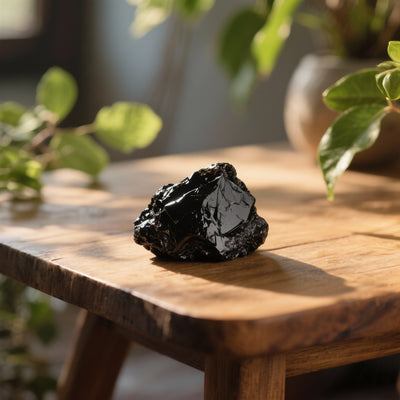Common Misconception: Is the "real" Shilajit only found in certain sacred mountains?
Shilajit, this powerful black resinous substance, is shrouded in mystery and ancient legends. One of the most persistent beliefs, often amplified by clever marketing, is that the "real" Shilajit, the purest and most potent, can only come from a few sacred peaks in the Himalayas. This idea evokes images of monks harvesting the substance in almost mystical conditions. But does this narrative, however seductive, stand up to the scrutiny of science and geology?
For consumers concerned with quality and authenticity, this question is crucial. Should we blindly trust the "Himalayan" label as the sole guarantee of quality? This article aims to debunk this myth. We will explore the true geological nature of Shilajit, discover the other regions of the world where it forms, and above all, give you the tools to identify a high-quality product, far beyond marketing tales and legends.
Understanding Shilajit: A geological treasure, not a mystical exclusive
Before discussing its origin, it's essential to understand what Shilajit actually is. It's not a tree sap or a typical plant resin. Shilajit is a complex biomineral substance , the result of a natural process spanning centuries, even millennia. It's what's known as a humic substance.
Imagine plant biomass (plants, mosses, lichens) trapped between layers of rock in very high-altitude regions. Under immense pressure, freeze-thaw cycles, and the action of specific microorganisms, this matter slowly decomposes and transforms. It becomes enriched with unique minerals and organic compounds, eventually seeping from the rock as resin when the summer heat liquefies it. The key components that result are:
- Fulvic acid: The main bioactive component, acting as an exceptional transporter of minerals to the cells of our body.
- Dibenzo-α-Pyrones (DBP): Powerful antioxidants and cell protectors.
- More than 84 minerals and trace elements in ionic form, highly bioavailable.
This process is not linked to the "sacredness" of a mountain, but to specific geological and climatic conditions: high altitude, intense pressure, specific flora and a pure ecosystem.
"The quality of Shilajit does not depend on the name of the mountain, but on the altitude, the purity of the ecosystem, and above all, the harvesting and purification methods used."
The geography of Shilajit: A global high-altitude phenomenon
While the Himalayas are historically the most well-known source of Shilajit, particularly due to its central role in Ayurvedic medicine, they are far from being the only ones. The conditions conducive to its formation are found in several other mountain ranges around the world. The name may change, but the fundamental substance remains the same.
Beyond the Himalayas: Other sources of high-quality Shilajit
Scientific research and local traditions confirm the presence of this substance in other regions:
- The Altai Mountains (Russia, Kazakhstan, Mongolia): Here, Shilajit is often called Mumijo (or Moomiyo). It is a historically very important spring, extensively studied in Russia for decades for its adaptogenic properties. Altai Mumijo is renowned for its high purity, as the ecosystem in this region is one of the least polluted in the world.
- The Caucasus (Georgia, Azerbaijan): Another traditional source where the substance has been known and used locally for generations for its mineral richness.
- The Karakoram and the Hindu Kush (Pakistan, Afghanistan): These ranges, neighboring the Himalayas, produce a Shilajit of quite comparable quality.
- The Tian Shan mountains (Kyrgyzstan, China): They also contain deposits of this precious resin.
The mineral composition can vary slightly from region to region, just as the taste of a wine varies depending on the terroir. However, a high-quality Shilajit from the Altai Mountains and a high-quality Shilajit from the Himalayas will share the same fundamental active compounds and offer similar benefits.
The real criteria for quality: What marketing forgets to tell you
Rather than focusing on a geographically driven marketing strategy, your attention should be on objective and verifiable criteria. An authentic and effective Shilajit is distinguished by four fundamental pillars.
-
Purity and absence of contaminants
Raw Shilajit is a natural substance that seeps from the rock. It therefore inevitably contains impurities: rock debris, soil, and potentially heavy metals (lead, arsenic, mercury) naturally present in the ground. A purification process is absolutely essential . Always insist on tests performed by an independent third-party laboratory that guarantee the absence of these contaminants. This is the number one safety criterion.
-
The concentration of fulvic acid and DBP
This is the measure of your Shilajit's potency. A high-quality product should have a fulvic acid concentration of at least 50%. This information, if not explicitly stated, should be available through the brand's Certificates of Analysis (COA). A low concentration may indicate poor-quality raw materials or dilution.
-
The purification method
Heat destroys the complex organic molecules and beneficial enzymes in Shilajit. Traditional purification methods involved simple dissolution in water and filtration, followed by sun-drying. The best modern methods build upon this by using low-temperature purification. Be wary of products made using high-heat processes, which alter the molecular structure and potency of Shilajit. For more information on testing methods, see our information blog .
-
Form and authenticity
Shilajit comes in several forms, but the purest is the semi-solid resin. Powders, while more convenient, are more likely to contain fillers, anti-caking agents, or be the result of high-temperature processing. Pure, sticky, dark resin is a sign of a minimally processed and authentic product.
Conclusion: Choose science, not myth
The idea that the only true Shilajit comes from sacred mountains is a marketing simplification that does a disservice to the informed consumer. While Ayurvedic tradition has beautifully highlighted the benefits of Himalayan Shilajit, science and geology show us that this natural treasure is not confined to a single mountain range.
Superior quality is found where the ecosystem is pure, harvesting is respectful, and purification is rigorous. Your power as a consumer lies in your ability to ask the right questions and demand transparency.
Your checklist for making an informed choice:
- Request certificates of analysis (COA): Check the purity (absence of heavy metals) and the potency (fulvic acid content).
- Opt for resin: It is the most traditional form and the least likely to be altered.
- Question the purification method: Ensure that it is carried out at a low temperature to preserve the integrity of the product.
Armed with this knowledge, you can confidently choose Shilajit, whether it comes from the Himalayas, the Altai Mountains, or the Caucasus. You're investing not in a beautiful story, but in an authentic, pure, and potent product. Ready to incorporate this gift of nature into your routine? Discover our recipe ideas for simple and delicious ways to use it.





